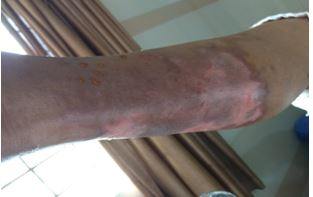Management of an Infective Ulcer : A Case Study
Keywords:
Dushta Vrana, Infective Ulcer, Panchavalkala Kashaya, Yashtimadhu Ghrita, Case ReportAbstract
The development of wound infection depends on the complex interplay of many factors. Nowadays, leg ulcers are at a rise due to increase in elderly population, life style changes and has been a common feature associated with infection, malignancy, adverse drug reaction, trauma and haematological disorders. Hence timely and effective management of ulcer is necessary. A patient of infected leg ulcer aged 62 years female presented with ulcer over right lower limb. The patient was treated with Panchavalkala Kashaya Parisheka followed by Yashtimadhu Ghrita dressing for 1 week following which the ulcer healed completely within 2 weeks and no recurrence in the 2 months of follow up.
Downloads
References
Shubhangi Vinayak Agale, “Chronic Leg Ulcers: Epidemiology, Aetiopathogenesis, and Management”, Ulcers, vol. 2013, Article ID 413604, 9 pages, 2013. https://doi.org/10.1155/2013/413604
Vijayakumar, A comparative study of Kaseesadi Avachurnana and Jatyadi Ghrita application in the management of Dushta Vrana, Ph.D thesis, Bengaluru: Rajiv Gandhi University of Health Sciences;2015
Bhat KS, Vishwesh BN, Sahu M, Shukla VK. A clinical study on the efficacy of Panchavalkala cream in Vrana Shodhana w.s.r to its action on microbial load and wound infection. Ayu. 2014 Apr;35(2):135-40. doi: 10.4103/0974-8520.146216. PMID: 25558157; PMCID: PMC4279318
Acharya Sushruta, Sushruta Samhitha, Dalhana, Nibandhasangraha Commentary, Edited by Jadavji Trikamji Acharya and Naarayana Ram Acharya; Varanasi: Chaukhambha Sanskrit Sansthan; Reprint 2012; Chikitsa Sthana 1/7,Pp 820,p397
Acharya Sushruta, Sushruta Samhita, Dalhana, Nibandhasangraha Commentary, Edited by Jadavji Trikamji Acharya and Narayana Ram Acharya; Varanasi: Chaukhambha Sanskrit Sansthan; Reprint 2012; Sutrasthana 37/22,Pp 820,p162















